- Testing Basics
- Home
- /
- Learning Hub
- /
- Detailed Guide to Cucumber Testing
- -
- September 21 2023
Detailed Guide to Cucumber Testing
Optimize software development with Cucumber testing. Gain clarity in cucumber language, streamline collaboration, and automate testing for precision.
OVERVIEW
Testing plays a vital role in software development by identifying, recognizing, and resolving issues before they impact users. It's a great way to ensure the code is stable and dependable.
Most companies are adopting a proactive approach to harness the power of software testing. They're integrating many essential acceptance test scenarios in development, also known as Behavior-Driven Development (BDD).
BDD places its primary emphasis on generating test scripts from various viewpoints, including those of both developers and customers. Initially, a successful definition of highly effective test scenarios is established through a strong collaborative effort that includes project managers, user acceptance testers, developers, quality assurance professionals, and the product owner. These scenarios are later translated into plain English text, which serves as documentation and testing instructions.
Cucumber is a valuable and popular open-source testing framework that facilitates BDD. Specifically, it acts as a testing framework driven by straightforward English text. It serves three primary purposes: automating tests, documenting the software, and facilitating development simultaneously.
What is BDD?
BDD stands for Behavior-Driven Development. It evolved from Test Driven Development and is an approach to software development that improves collaboration and mutual understanding between technical and non-technical teams.
It involves crafting different test cases in the form of easy-to-understand English statements within a manually-generated feature file. These statements center around the system's behavior and are highly user-centric.
The primary goal of BDD is to encourage clear communication among testers, product managers, developers, and stakeholders throughout the development process. It defines and illustrates a software's anticipated behavior via concrete examples in a universally understandable language.
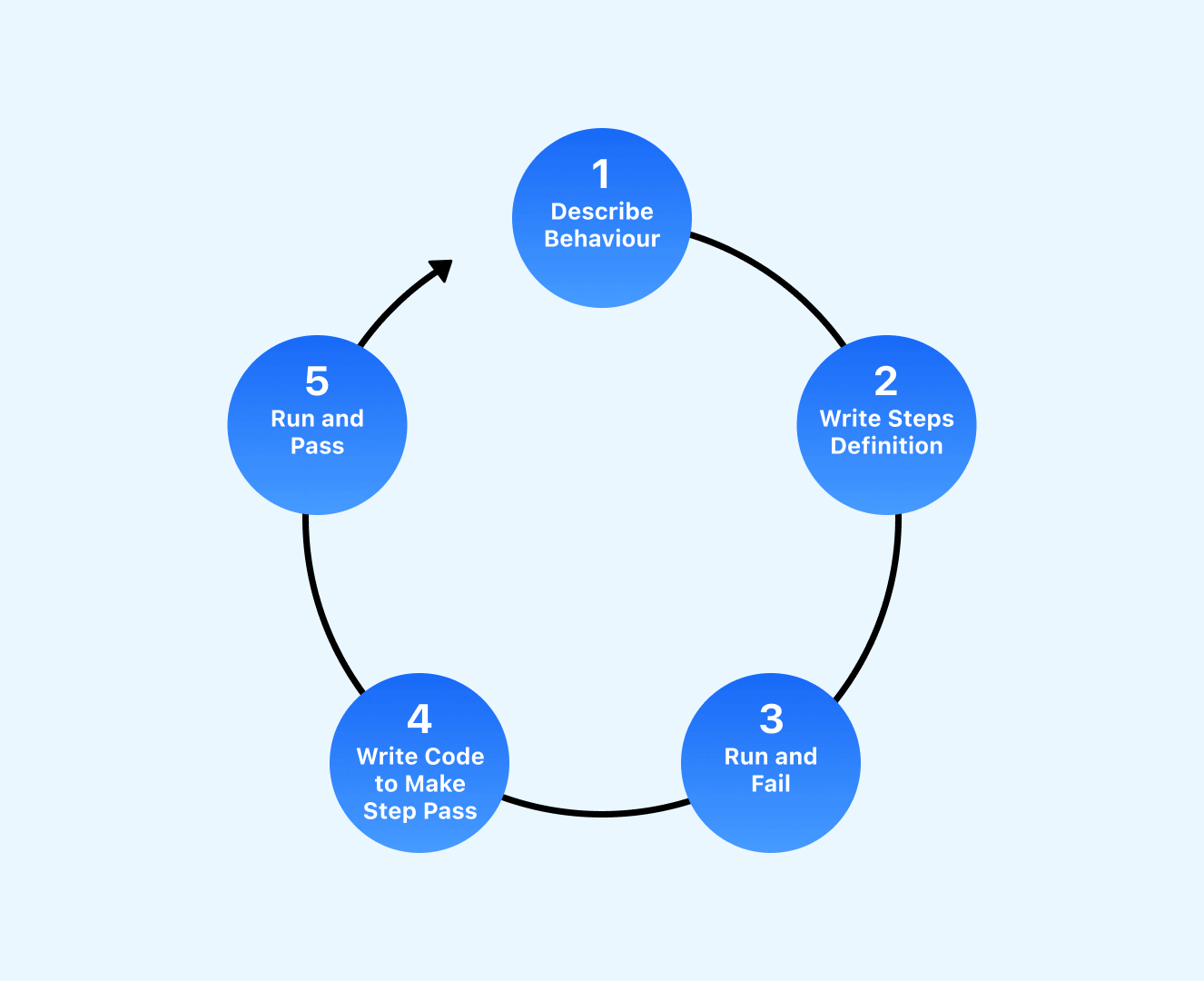
Instead of traditional programming languages, BDD employs plain and simple English sentences. This approach bridges the gap between technical and non-technical users and teams, fostering better collaboration.
These instances are "scenarios," and their structuring uses a straightforward, business-readable language called Gherkin.
Gherkin employs concise keywords like "Given," "When," and "Then” to depict actions, scenario preconditions, and anticipated results.
BDD isn't just a testing methodology. It's a proven method of enhancing communication, collaboration, and understanding of software behavior. While acknowledging the pivotal importance of testing, BDD's core objective is to help everyone collaborate in a way that ensures the software works the way it's supposed to.
It brings multiple benefits, including shared comprehension, broader test coverage, enhanced communication, and improved alignment between main business objectives and the respective development activities. It also promotes a customer-focused approach by emphasizing software behavior from the end users' perspective.
The BDD Process
Behavior-driven development or BDD, is an approach to software development that aims to enhance collaboration and communication among testers, developers, and stakeholders. It also emphasizes the software's behavior instead of just technical details. It involves writing tests in a language everyone on the project can easily understand. The process of BDD involves these steps.
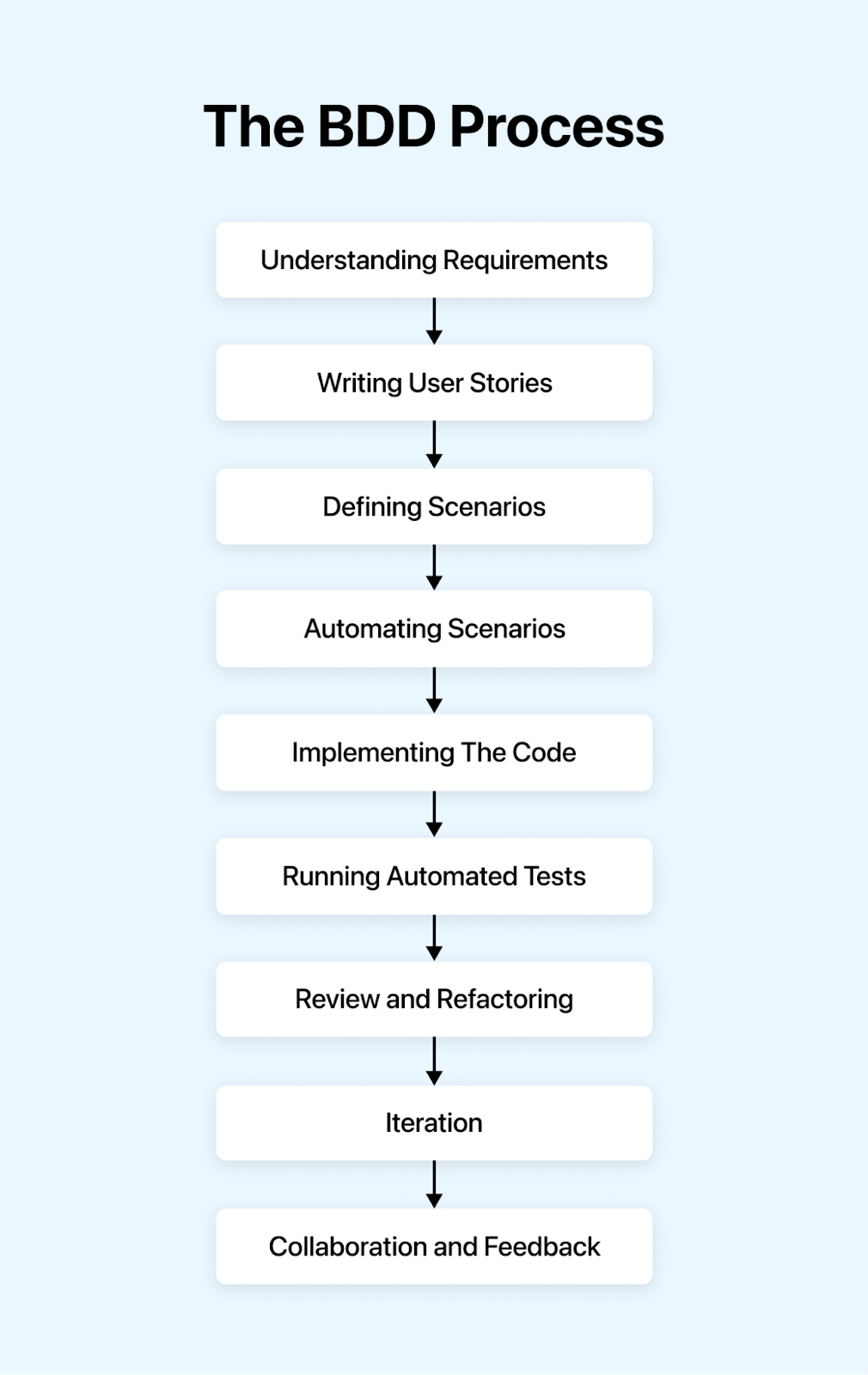
- Understanding Requirements
- Writing User Stories
- Defining Scenarios
- Given: Describes initial system conditions.
- When: Depicts actions or events.
- Then: Expresses anticipated outcomes.
- Automating Scenarios
- Implementing The Code
- Running Automated Tests
- Review and Refactoring
- Iteration
- Collaboration and Feedback
To create a well-functioning software application, we must collect and grasp its specific requirements. This process involves having conversations with individuals like product owners, stakeholders, and domain experts. They help us pinpoint what software needs to achieve and the outcomes we anticipate from it.
User stories refer to concise descriptions of specific features or functionalities from an end-user's point of view. They serve as a steady foundation for defining a software's behavior.
Scenarios are real-world examples illustrating how the software should behave in various situations. They use the Gherkin format, which utilizes natural language syntax and has Given-When-Then-And steps.
Development teams then automate these scenarios using testing tools like Cucumber or SpecFlow. These tools interpret Gherkin syntax and execute corresponding tests.
During this stage, the concrete software development process occurs. Skilled developers write necessary code while ensuring it harmonizes with the predefined test scenarios and brings the system's intended behavior forward. They craft the functional core of the software to make it perform according to desired expectations.
In this stage, the tangible software development process occurs. The development team takes the automated tests from the Gherkin scenarios and applies them to the newly created code. This step confirms whether the software behaves precisely as intended. It ensures that the implemented functionality fully aligns with the envisioned behavior.
In this stage, the real work of software development takes place. The team carefully examines the code and the tests, making any necessary adjustments and refinements. This entire review and adjustment process enhances a software's quality and reliability.
BDD is highly iterative. The team repeats these steps for each new feature or improvement, thus consistently refining software requirements and behavior.
Developers, testers, stakeholders, and team members collaborate and offer feedback throughout the process. It ensures the software is on the same page as the desired behavior and project goals.
Benefits of BDD
Following the BDD process enables teams to create software that meets user and stakeholder needs. This results in improved communication, fewer defects, and enhanced customer satisfaction. Here are some benefits of BDD.
- Enhanced Collaboration
- Clear communication
- Increased Test Scope
- Swift Feedback
- Lowered Expenses
- Enhanced Agility
- Elevated Quality
BDD fosters collaboration among business stakeholders, developers, and testers. This ensures everyone is on the same page about business goals and that the software aligns with those goals.
BDD employs plain language, making it understandable to non-technical stakeholders. This facilitates clear communication of requirements and expectations, bridging gaps between teams.
BDD concentrates on the software's behavior, assuring comprehensive coverage of vital scenarios. This minimizes the risk of introducing bugs and errors.
During this stage, which encompasses real software development, BDD plays a pivotal role. It swiftly notifies developers of potential issues, which minimizes the time taken to identify and resolve these concerns. This efficient process ensures the software is delivered punctually and within the predetermined budget.
BDD identifies and resolves issues early, cutting overall development costs. Addressing problems in earlier stages is more cost-effective than doing so later.
BDD adapts to evolving business needs, promoting flexibility and agility. This guarantees that the software remains aligned with changing objectives.
BDD ensures the software meets business needs, enhancing quality, user satisfaction, and reliability. The end product is user-friendly and dependable.
What is Cucumber Testing?
Cucumber is a tool in BDD that focuses on defining a software application's behavior with clear examples before coding. It helps foster understanding in developers about the desired behavior of the application and facilitates seamless collaboration with stakeholders. Cucumber is also beneficial in automated testing as it offers clear and easily understandable testing scripts for automation and system acceptance testing.
It also results in more accurate, precise, and accessible applications. The best part is that Cucumber is accessible to individuals with varying technical expertise.
Note : Elevate your Cucumber testing with LambdaTest. Sign up for a free trial today and see the impact on your testing workflow! Try LambdaTest Now!
Advantages of Cucumber Testing
Cucumber testing is widely embraced in software development for behavior-driven development. It brings benefits to developers and stakeholders involved in software projects. Here are some important advantages of using Cucumber testing.
- Readability and Clarity
- Collaboration and Shared Understanding
- Reusability
- Test Documentation
- Integration with Multiple Programming Languages
- Functional Testing
- Leverage Cucumber in Agile Projects
- Test Automation
- Continuous Integration and Delivery
- Behavior Driven Development
- Test Visibility
Cucumber testing utilizes a plain text format called Gherkin to describe test scenarios. This straightforward approach enhances the readability and understanding of test cases, making it easier for non-technical stakeholders like product owners and business analysts to grasp. It bridges the communication gap, allowing collaboration and mutual understanding between technical and non-technical team members.
Cucumber testing scenarios are written in a business domain-specific language (DSL). By expressing tests in this language, developers, testers, and stakeholders can collaborate effectively. This shared understanding ensures everyone has a vision of how the software should behave.
Cucumber testing allows for the reuse of step definitions, which are the underlying implementations of Gherkin steps. This promotes modularity and reduces code duplication, making test maintenance more manageable and efficient. It results in development time, increased productivity, and streamlined maintenance. Cucumber is a choice even for complex projects beyond just the user interface.
Cucumber testing scenarios act as documentation for software behavior. They provide a structured overview of the features and functionalities of an application. This documentation remains current as long as tests are regularly maintained and executed.
Cucumber seamlessly integrates with programming languages such as Java, Ruby, Python, and more. This flexibility empowers development teams to write tests using their preferred programming language. It allows them to work smoothly with tools and frameworks they're most comfortable with.
Cucumber facilitates cross-functional testing by integrating multiple application layers (e.g., front end, back end, and database) into one comprehensive test scenario. This ensures end-to-end testing that helps identify any potential integration issues.
Cucumber's adaptability to diverse stakeholders and intuitive acceptance of test case creation make it invaluable. Its contribution to development includes refining testable scenarios, aligning the product with user needs, and improving product quality before the final release.
Cucumber supports test automation, enabling teams to automate test cases. Automation is a time and effort-saving tool, especially regarding regression testing or working with complex systems.
Cucumber seamlessly integrates into CI/CD pipelines, making automated testing a part of the continuous integration and delivery process. This ensures that new code changes are thoroughly tested before deployment, reducing the risk of introducing bugs.
Cucumber follows BDD principles by describing application behavior from the users' perspective. This user-centric approach ensures that tests align with user requirements and business goals.
Cucumber provides test reports outlining successful and unsuccessful scenarios. These reports offer insights into the robustness and quality of the application, enabling teams to address any issues promptly.
These benefits highlight the role of Cucumber testing in improving software quality, fostering collaboration, and speeding up development processes.
Limitations of Cucumber Testing
Even though Cucumber is one of the most widely used BDD & acceptance testing tools, it does come with limitations that testers and developers should be aware of. Here they are.
- Execution Time
- Reliability on UI
- Maintenance Overhead
- Limited Parallel Execution
- Complexity
- Data Management
- Insufficient Technical Details
- Limited Test Coverage
- The Complexity of Integration
The Cucumber testing can be slow, especially as the test suite grows. Each scenario in the feature files requires setting up the test environment and executing steps, increasing execution times.
Cucumber testing often depends on the user interface of the application, which makes them susceptible to changes in the UI. Minor alterations to the UI can cause test failures even if the core functionality remains unaffected.
Managing and updating several feature files and scenarios can become challenging as quantity increases. Sometimes, the effort required to keep tests current may outweigh their benefits.
The support for execution in the Cucumber testing varies depending on the chosen test framework. This could impact the ability to scale up the test suite for projects efficiently.
Cucumber testing can become complex, particularly when dealing with scenarios, background steps, and data tables. Crafting and understanding feature files can be overwhelming for team members with limited experience with BDD techniques.
Dealing with test data in complex data setups can present challenges in Cucumber tests. Using data tables within feature files can become cumbersome, and managing test data might require generation or clearing between test runs.
Cucumber testing promotes the writing of tests in a natural language format to make them accessible to technical stakeholders. However, this approach may lack the precision offered by traditional automated tests.
Cucumber testing excels in level end-to-end testing and behavior verification but may not cover all edge cases or delve into low-level details that unit or integration tests can effectively target.
Integrating Cucumber with testing frameworks, build tools, or continuous integration systems can introduce additional complexities.
Common Cucumber Challenges with Resolutions
Cucumber, like any tool, comes with challenges. Fortunately, there's no shortage of solutions available. Let's check them out.
Maintenance Challenges
As the application and maintaining feature files, step definitions, and associated code can become difficult. Problems like duplication, unclear steps, and outdated scenarios can create maintenance headaches.
Resolution:
- Regularly review and refactor your Cucumber scenarios.
- Avoid repeating steps by creating step definitions.
- Consider utilizing scenario outlines for test cases.
- Use tags to organize and categorize scenarios for management and targeted test runs.
Slow Test Execution
Cucumber testing tends to be slower than unit tests due to the involvement of starting up the application and simulating user interactions through the UI.
Resolution:
- Primarily utilize Cucumber for end-to-end testing purposes.
- Place emphasis on unit and integration tests for feedback during development.
- Implement test execution to speed up testing processes.
- For UI testing, explore options like browsers or UI automation tools.
Fragile Tests
If your Cucumber testing scenarios are too reliant on UI elements or implementation details, they may break when changes are made to the application—even if the intended functionality remains unchanged.
Resolution:
- Adhere to practices in behavior-driven development.
- Focus on high-level scenarios that describe application behavior without specifying implementation details. Use data attributes and unique identifiers to ensure interactions.
- Separate tests from UI specifics by utilizing page objects or abstractions.
Data Management
Managing test data in complex scenarios that require specific setups can pose challenges. Reusing test data across scenarios and maintaining data consistency can be difficult.
Resolution:
- Implement test data factories or fixtures to ensure reusable data.
- Consider using database transactions or rollback mechanisms to reset the data between different scenarios.
- Explore the possibility of employing data-driven testing with datasets.
Ambiguous Language
The Gherkin syntax, which relies on language, can sometimes result in ambiguous scenarios or steps open to interpretation.
Resolution:
- Collaborate with stakeholders, developers, and testers to establish a shared understanding of scenarios.
- Consistently use the Given-Then format for clear and explicit scenarios.
- When defining steps, use descriptive language.
Lack of Technical Skills
Cucumber testing requires technical expertise from team members. Non-technical stakeholders may find it challenging to read and contribute to feature files.
Resolution:
- Provide training and support for technical team members to enhance their understanding of testing principles and Gherkin syntax.
- Encourage collaboration by involving stakeholders in feature file reviews and discussions. To optimize the benefits of Cucumber testing, teams should focus on tackling these obstacles. This will not only improve collaboration but also enhance the effectiveness of testing efforts.
Difference Between Cucumber Testing and Traditional Testing
Cucumber testing and traditional testing both serve the purpose of validating a software application's functionality. However, they diverge in approach and tooling. Here is a breakdown of their key distinctions.
| Aspect | Traditional Testing | Cucumber Testing |
| Testing Approach | Testers use programming languages (e.g., Java, Python) | Adopts BDD approach with human-readable Gherkin |
| Test Scenario Format | Specific syntax of chosen programming language | Gherkin syntax in natural language |
| Readability and Collaboration | Less accessible to non-technical stakeholders | More understandable to non-tech team members |
| Tooling and Integration | May rely on specific frameworks and additional tools | Serves as a tool integrated with Cucumber-Ruby, Cucumber-JVM, Cucumber-JS, etc. |
| Test Maintenance | Requires technical modifications when application changes | Allow updates via plain-text scenarios without changing code |
| Focus on Collaboration and Business Value | Emphasizes technical aspects, may not convey business goals | Prioritizes expected behavior and business requirements |
Which Language is Used in Cucumber?
Cucumber was initially developed using Ruby to test applications with Ruby alongside the RSpec BDD framework. However, it has expanded its support to various other programming languages, including JavaScript, PHP, Java, .NET, Python, and Perl, with versatile implementations. The choice of language usually depends on the team's familiarity with the programming language.
Gherkin
In Cucumber testing, you create feature files with executable test scripts. These executable test scripts are in a language known as Gherkin.
Gherkin is a domain-specific language to compose executable specifications in a readable format. It employs keywords like And, When, Given, Then, and But to articulate the various steps of a test scenario.
Essentially, Gherkin serves as a plain English text language for interpreting and executing various test scripts.
Why Gherkin?
BDD encompasses various software behavior development possibilities while crafting test scripts. Such possibilities can relate to development or business aspects. So, to address these diverse requirements, a collaborative effort involving testers, product owners, developers, and project managers is important during test script development.
Since the stakeholders come from different backgrounds, using a common language becomes challenging and poses a risk to the effectiveness of test scripts. Gherkin was developed to mitigate this risk.
Gherkin offers a shared set of keywords in English that is easily understandable by members from various backgrounds, thus ensuring consistent outcomes from test scripts.
How Gherkin Works?
Gherkin functions by creating Step Definitions that connect steps and the corresponding code. It also accommodates keywords in different languages, such as French, and step definitions are in various programming languages like JavaScript.
Here's a clear breakdown of the basic structure:
- Cucumber tests are organized into Features that represent specific functions under test.
- Each Feature is further subdivided into Scenarios, which describe a sequence of events and correspond one-on-one with executable test cases for the system. They often contain multiple Scenarios.
- Defining Scenarios involves a sequence of Steps describing the sequence of events, including actions taken, conditions that need to be met before, and expected outcomes. This uses keywords like When, Then, Given, And, and But to structure and clarify the scenario.
How to Install Gherkin?
To use Gherkin, you need to activate the Gherkin plugin. To install the Gherkin plugin into your Cucumber framework, follow these steps.
Step 1: Open IntelliJ, and make sure your working project is open.
Step 2: Open Plugins Setting by going to File > Settings > Plugins.
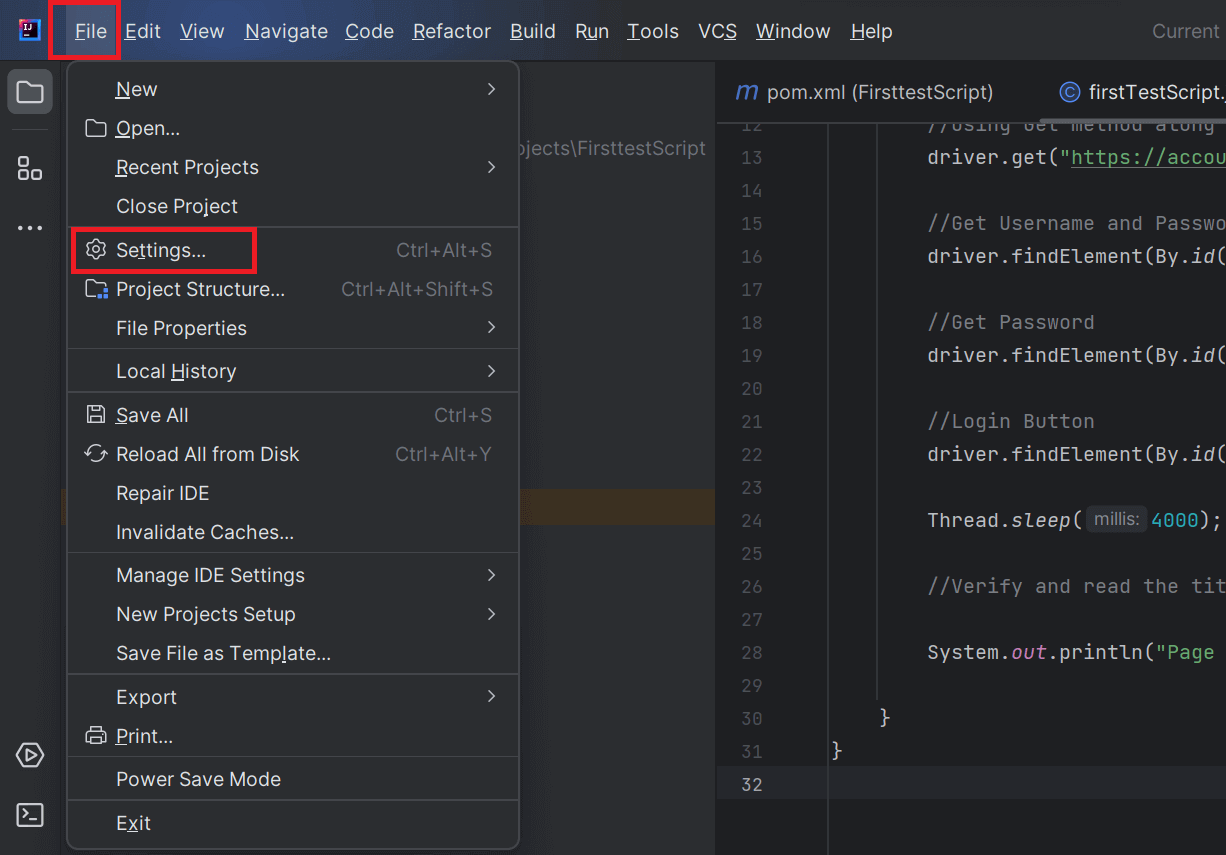
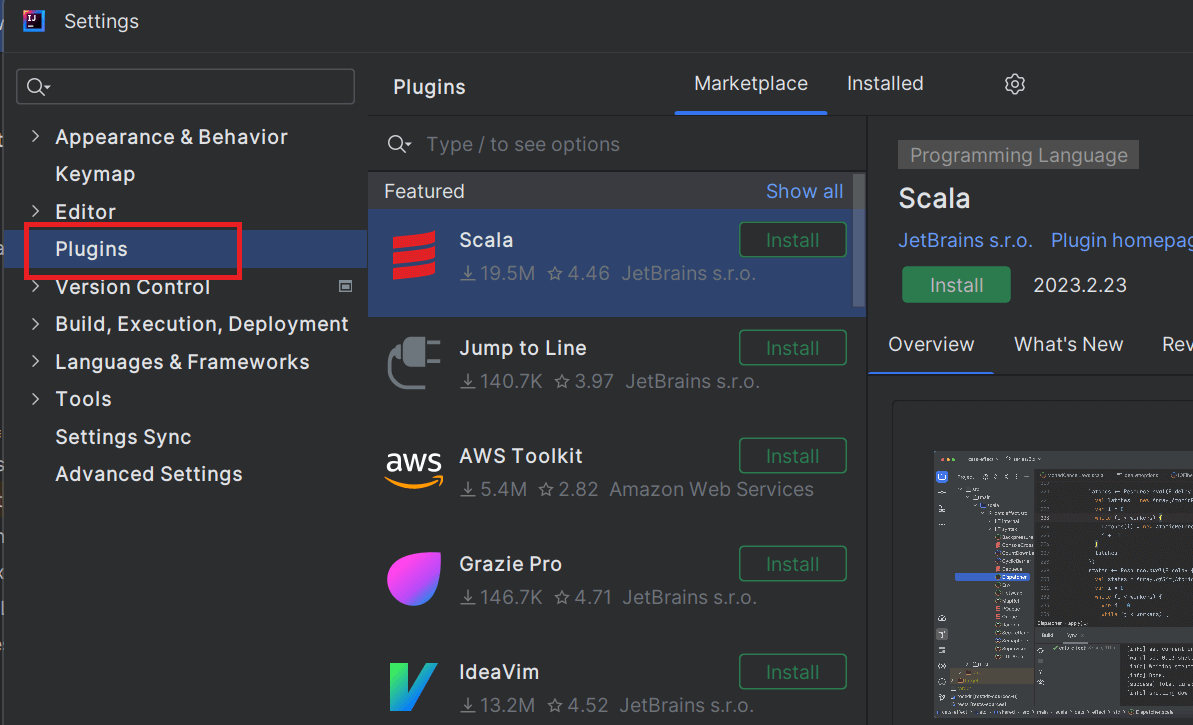
Step 3: In the Plugins section, make sure you are under the Marketplace tab. In the search bar, write Gherkin
Step 4: Locate the Gherkin plugin in the search results and install it by clicking the Install button.
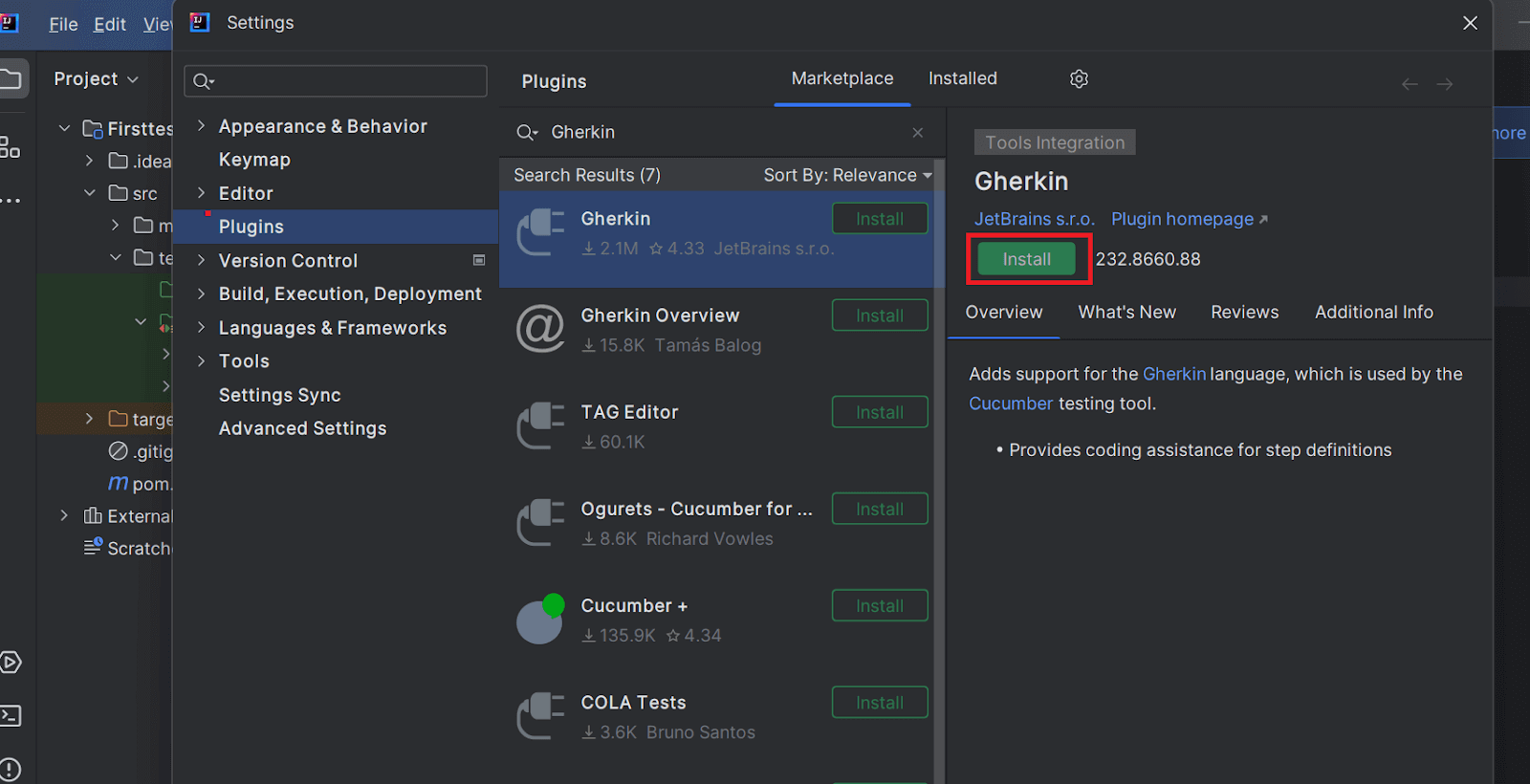
Step 5: After the installation is complete, the IDE needs to be restarted. Click on the Restart IDE button.
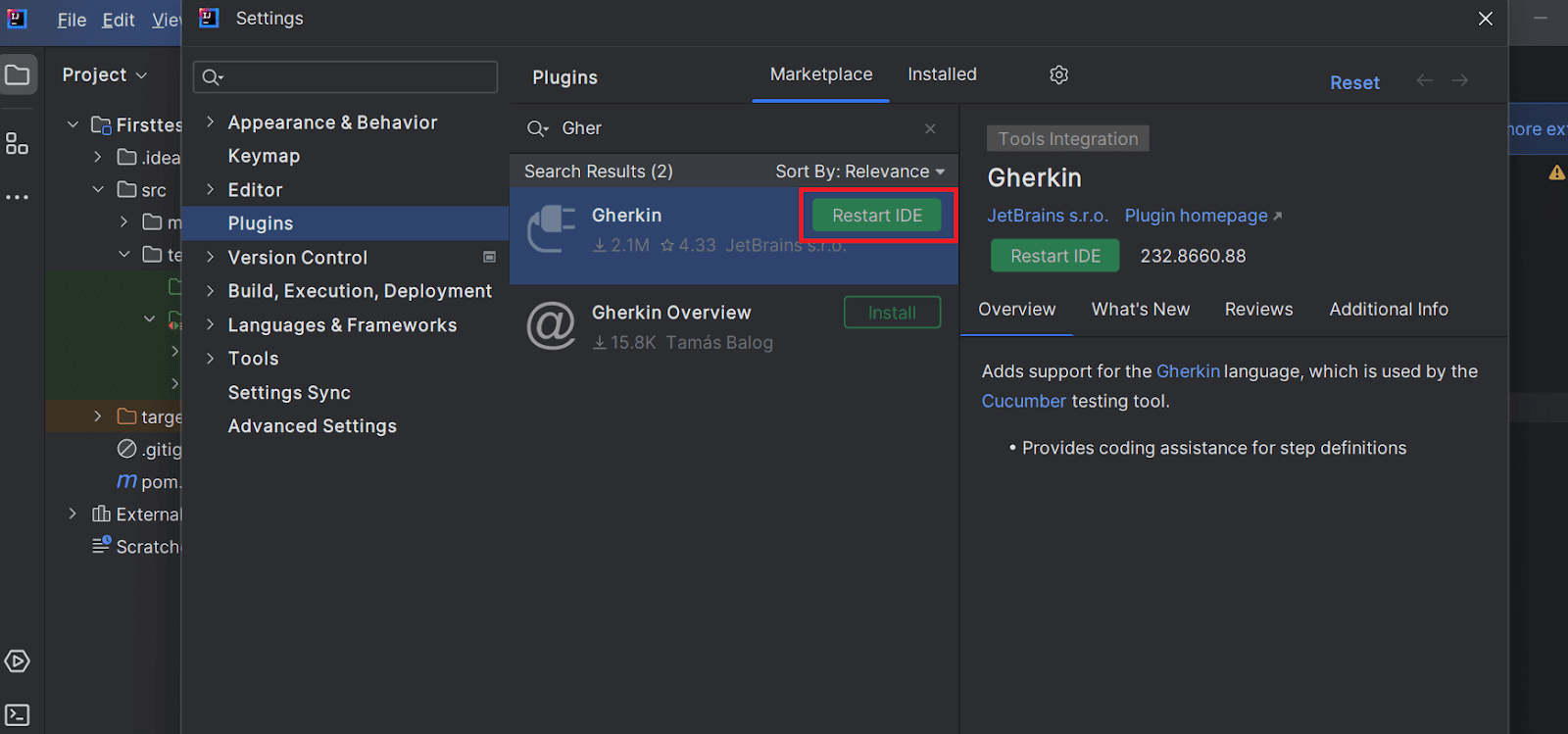
Step 6: Now that you have the Gherkin plugin installed, you can create a new Gherkin (.feature) file or open an existing one in your project.
Creating Feature file
To create a new feature file, you can right-click on any directory from your project, or you can create a feature file under the resource folder to handle all your project supportive files." src/test/resources" and save the file with (.feature) extension.
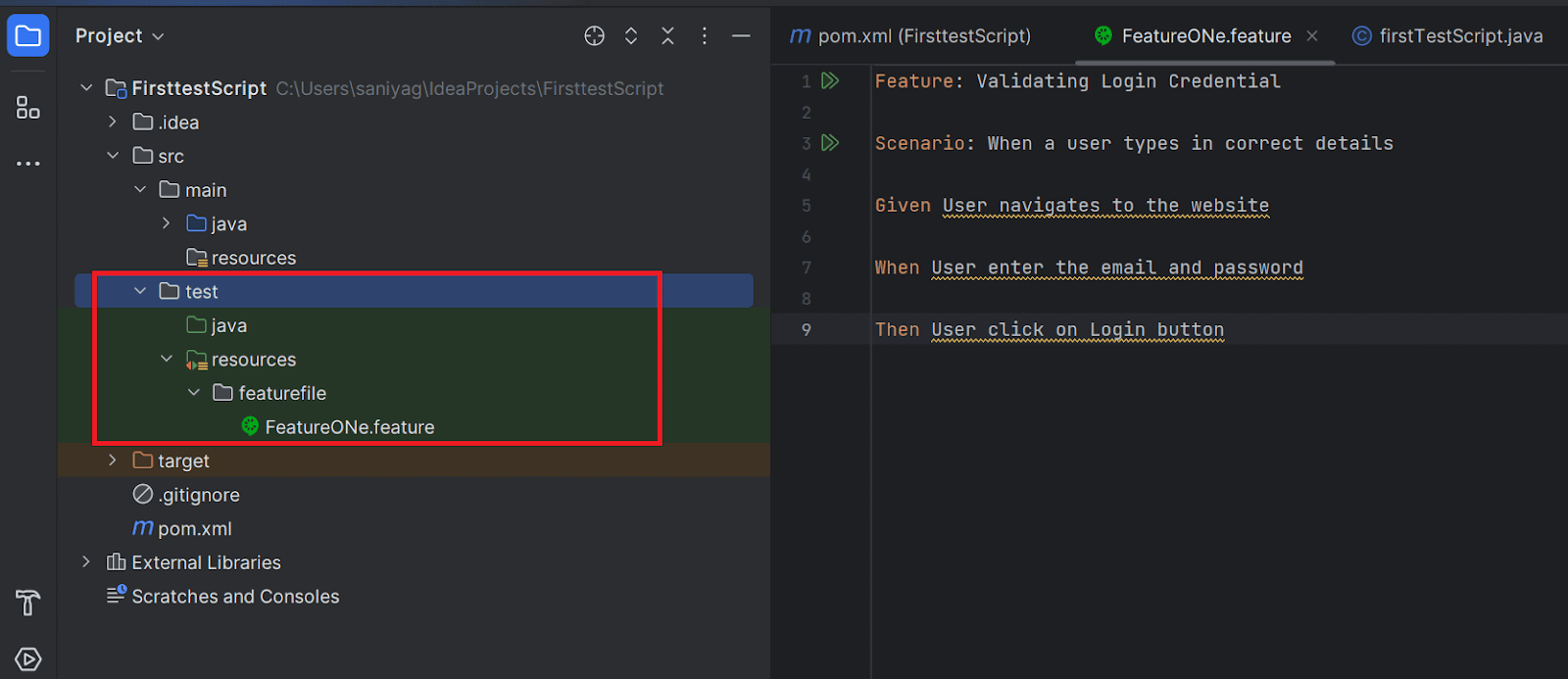
Gherkin Keywords
Gherkin scenarios outline how software applications should behave in different situations. To define various parts of a scenario using specific keywords. Here are some primary Gherkin keywords.
Feature: This keyword defines a wide description of the feature or functionality being tested. A Gherkin file typically starts with a Feature definition.
- Feature: Testing the Login Functionality
Scenario: A scenario represents a specific test case that portrays a particular function or behavior of the software application. Each Scenario is distinct and has to possess a unique name.
- Scenario: Successful User Login with Valid Credentials
Scenario Outline: This keyword creates a scenario template that can be executed with various data sets called scenario examples.
- Scenario Outline: User Login with Different Roles
Examples: Specify different input data sets for a Scenario Outline followed by a table with headers acting as placeholders in the Scenario Outline.
- Examples:
| Role | Username | Password |
| Admin | adminuser | password1 |
| Customer | custuser | password2 |
Given: Describe the initial preconditions or context for the scenario. It sets up a test by defining a system's initial state.
- Given the user navigates to the login details
When: Represents an action or event in the scenario. It describes a specific user interaction or a system behavior under examination.
- When the user enters valid credentials
Then: Specify an anticipated outcome or result of the scenario. It outlines an expected behavior or state of the system following the action mentioned in the "When" step.
- Then the user should be successfully logged in
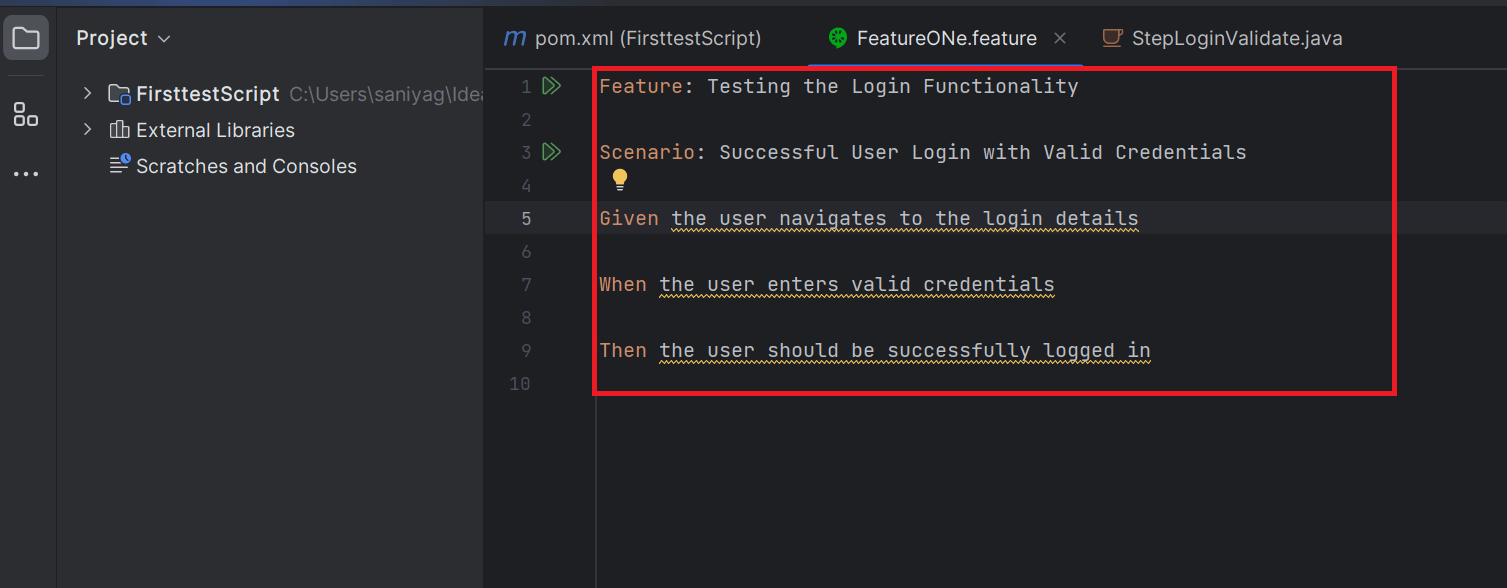
And: Include additional steps within a scenario, thus ensuring conciseness and readability by preventing repetitive keywords
- And the user should be able to see the dashboard
But: Employed for supplementary steps, especially when the additional step signifies unexpected or adverse outcomes.
- But the user shouldn't have access to the admin panel
These Gherkin keywords establish the foundation for BDD scenarios, thus facilitating the creation of structured and easily comprehensible specifications for all development team members.
Step Definitions: A Bridge from Scenarios to Code
Step Definitions in the context of BDD and TDD frameworks are the code that defines the actions for every step in a test scenario. They are written in those programming languages used to implement the steps in Gherkin. Some of the most commonly used programming languages for writing step definitions in Cucumber are.
- Ruby: Ruby is the original language in Cucumber’s development and remains a popular choice.
- Java: Java, another widely-used language for writing step definitions with Cucumber, is also a popular choice.
- JavaScript: JavaScript is usually for testing web applications, thanks to the popularity of Node.js in web development.
How do Step Definitions Work?
Step definitions link human-readable Gherkin scenarios and automation codes that perform the corresponding actions. Here's how they work:
- Write Gherkin Scenarios: Write Gherkin scenarios in a Given-When-Then format, describing the system’s behavior in a human-readable language.
- Map Gherkin Steps to Step Definitions: Each Gherkin step, like Given, When, Then, is mapped to a corresponding step definition. The choice of programming languages, such as Java, JavaScript, Ruby, or Python, depends on the specific testing framework.
- Regular Expressions Matching: Step definitions use regular expressions to match the Gherkin steps in a particular scenario. Regular expressions are patterns used to identify specific text patterns in strings. For example, if the Gherkin step says, "Given I have 5 apples," the step definition uses a regular expression to match the phrase "I have (\d+) apples" and extracts 5, the number.
- Automation Code Execution: Once a step definition matches, the associated automation code executes. This code performs interactions, actions, or assertions on the system under test to ensure that it behaves as per expectations.
- Parameterization: Step definitions usually have parameters extracted from Gherkin steps with regular expressions. Such parameters serve as input for the automation code, thus making scenarios flexible and reusable.
- Reporting and Feedback: During a test scenario execution, the testing framework offers feedback, indicating whether every step passed or failed. Such feedback identifies the possible success or failure of that scenario and points to steps needing further investigation if they fail.
Step Definition Keywords
Step definition keywords are used in BDD and testing tools such as SpecFlow, Cucumber, and Behat to define the software behavior and create test steps. Check out some common step definition keywords:
- Given: Establishes an initial state or preconditions of a test scenario, thus setting the context for execution.
- When: Describes an action or event under test, representing the user action or a system behavior that triggers the scenario.
- Then: Defines an expected outcome or result, verifying that an application behaves as expected after the action.
- And: Extends When, Given, or Then steps by adding additional steps or conditions, enhancing expressiveness.
- But: Similar to "And," it adds alternative steps or conditions to express exceptions or varying paths.
Example of a Gherkin scenario that uses these step definition keywords:
Scenario: User login
Given the user is on the login page
When the user enters valid credentials
And clicks the login button
Then the user should be redirected to the dashboard
In Cucumber, each step (Given, Then, When, And, But) has corresponding step definitions written in the framework's programming language, like Java, Ruby, and Python, enabling an automatic execution and verification of tests.
How Does Cucumber Testing Work?
After writing scenarios in Gherkin and corresponding to a step definition, here is how Cucumber testing works.
- Setting Up the Test Environment
- Executing Cucumber Tests
- Generating Reports
- Continuous Integration and Automation
- Iterative Test Development
Before running Cucumber tests, it's important to configure the test environment with data, dependencies, and configurations. This involves initializing databases, configuring a web driver for web applications, or preparing mock data.
Once the test environment is ready with Gherkin scenarios and preparation of step definitions, you can run the Cucumber tests. Cucumber interprets Gherkin scenarios, aligns them with the relevant step definitions to execute the code linked to each step, and generates test reports.
Cucumber provides a comprehensive post-execution report and offers detailed insights into test outcomes. These reports include details about failed, passed, or pending scenarios, error messages, or stack traces for failed scenarios.
Cucumber testing often integrates into continuous integration pipelines. It enables automated testing when there are code changes. CI integration also helps identify bugs early in development and ensures new code doesn't introduce regressions.
As an application evolves, so do test scenarios. Developing and maintaining these Cucumber tests is a highly iterative process. Scenarios might require updates as new features come up or existing ones undergo changes.
Experience the testing future with LambdaTest! Sign up now for seamless collaboration, enhanced readability, and efficient test maintenance. Try LambdaTest Now!
How BDD Works in Cucumber Automation?
Behavior Driven Development (BDD) is an approach to software development that emphasizes collaboration between developers, testers, and business stakeholders. To implement BDD in automated testing, Cucumber is used.
In Cucumber testing, BDD scenarios are written in an understandable format called Gherkin. Gherkin relies on keywords to describe the behavior of the software. These keywords include
- Given: This describes the system's state before any behavior occurs.
- When: This keyword depicts the action or behavior being performed.
- Then: This keyword outlines the expected outcome or result of the behavior.
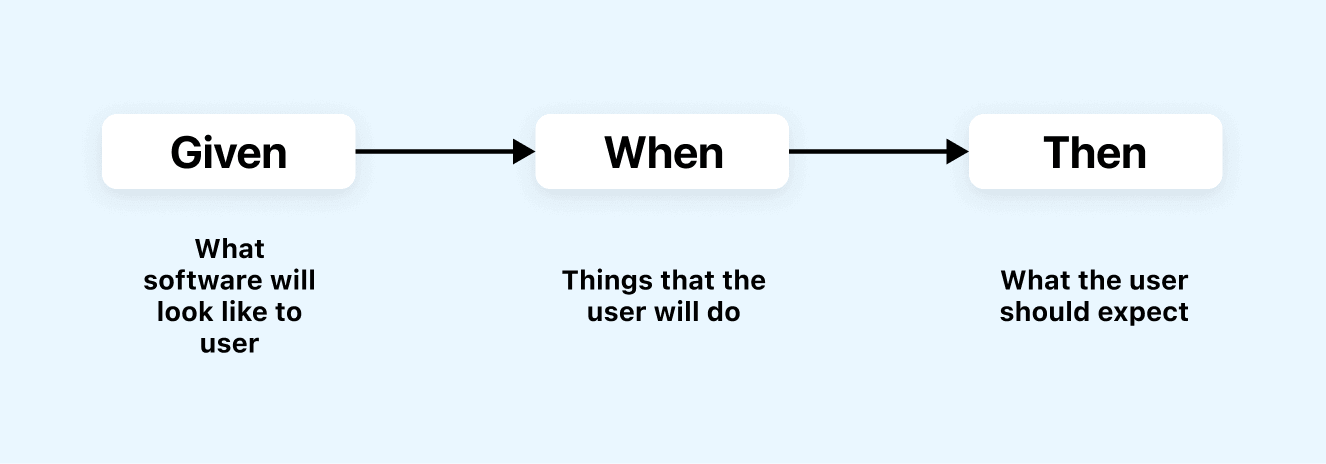
For example, let's consider a Gherkin scenario for a login feature.
Scenario: User logs in with credentials
Given that the user is on the login page
When they enter their valid username and password
Then they should be successfully logged in
Cucumber testing uses step definitions to connect these Gherkin steps with code that executes the desired behavior. Step definitions are written in programming languages with automation frameworks such as Java, Ruby, or Python.
How to Use Cucumber Framework?
The Cucumber testing framework is widely used in software testing for Behavior Driven Development (BDD). It offers a user approach to writing test scenarios and automating their execution.
Let's take an overview of how to utilize the Cucumber testing framework.
- Installing Cucumber
- Defining Feature Files
- Writing Scenarios in Gherkin
- Implementing Step Definitions
- Running Cucumber Tests
- Analyzing Test Results
Before starting with Cucumber, you must install it alongside a programming language like Java, Ruby, or JavaScript. Make sure to install the Cucumber library for your selected language.
Cucumber employs Gherkin, a human language, for defining test scenarios. Each scenario is typically defined within a feature file with the ".feature" extension. These feature files represent functionalities or features of the software.
Within the feature files, you can write test scenarios using the Gherkin “Given” structure. Each scenario comprises steps that begin with "Given," "When," or "Then," representing the context actions performed and expected outcomes, respectively.
Once you have written your scenarios, it's time to implement them in your chosen programming language.
Step definitions are snippets of code that define the actions to be performed in the software based on each step described in Gherkin syntax.
Once you've written your feature files and implemented the step definitions, you can run the tests. Cucumber will read through the feature files, match each step with its definition, and execute the scenarios.
Cucumber generates test reports that showcase the results of executed scenarios. These reports can be analyzed to identify any failures and track test coverage.
This is an overview of how to use Cucumber. Keep in mind that implementation details may vary depending on what programming language or testing framework you're using. Cucumber testing offers a range of features and integrations, with testing tools making it an excellent choice for behavior-driven development testing.
Installation of Cucumber
To install Cucumber, the process may vary depending on the programming language you use for your test automation. Cucumber is commonly used with languages such as Java, Ruby, JavaScript (Node.js), and others. Here are the installation steps for Cucumber with some programming languages.
- For Java (using Cucumber JVM)
- Use Cucumber JVM to integrate Cucumber with Java.
- Include the necessary dependencies (Cucumber Java and JUnit or TestNG) in your project build tool, like Maven or Gradle.
- For Ruby (using Cucumber Ruby)
- If you're working on a Ruby-based project, consider using Cucumber Ruby.
- Install the Cucumber gem by executing this command.
- For JavaScript (Node.js) (using Cucumber.js)
- With JavaScript and Node.js, you can utilize Cucumber.js.
- Install the Cucumber.js package using npm (Node Package Manager) with this command.


It's worth noting that you can find instructions for installing Cucumber in different programming languages on the official Cucumber website. Once you have successfully installed Cucumber and set up the dependencies, you can create your feature files and step definitions, as explained in the previous response.
Remember that Cucumber is designed for Behavior Driven Development (BDD), so make sure to write scenarios that are easy to understand for humans and accurately describe the expected behavior of your software.
It's always advisable to consult the documentation and resources specific to your chosen language and framework to ensure a seamless installation and setup process. Remember that since Cucumber is a tool used with various programming languages and testing frameworks, there may be slight variations in the setup process depending on your specific environment.
Types of Cucumber Tests
Cucumber tests are written using the Gherkin syntax, a plain text format. Here are some common categories of Cucumber tests.
- Feature Tests
- Scenario Tests
- Scenario Outline Tests
- Background Tests
- Data-Driven Testing
- Tags
- Hooks
- Step Definitions
Feature tests provide a high-level overview of how a software feature should behave from the user's perspective. They begin with the "Feature" keyword in Gherkin syntax. Outline the main functionalities of a specific feature.
Scenarios present examples of how a feature should function by describing specific interactions with the application. Each scenario is delineated by the "Scenario" keyword in Gherkin syntax.
Scenario outlines enable you to define a template for scenarios and run them with data sets. This functionality utilizes keywords such as "Scenario Outline" and "Examples" in Gherkin syntax, which proves useful when testing various input combinations.
The "Background" keyword allows you to define steps to execute before each scenario within a feature. It aids in establishing preconditions for multiple scenarios, reducing redundancy and improving readability.
In Cucumber, you can utilize tables or data sets written in Gherkin syntax to provide scenario input data. This empowers you to conduct data-driven testing, where you can execute the scenario with different data sets.
In Cucumber, tags serve to organize and categorize scenarios. They come in handy when you want to group related scenarios and selectively run subsets of tests based on those tags.
Cucumber allows the use of hooks, which are code snippets that run at specific points during the test execution lifecycle. Hooks can be utilized for tasks such as setting up and closing the application, managing test data, and more.
Step Definitions connect Gherkin scenarios and the actual code that executes the tests. They define how the steps described in the Gherkin language are implemented and interact with the application.
These are some of the used types of Cucumber tests that enable you to create behavior-driven development test suites for your applications. By employing Cucumber, you can ensure that your tests are easily readable, maintainable, and comprehensible by all stakeholders involved in the software development process.
When to Use Cucumber Testing?
Cucumber testing helps create acceptance tests for software applications. It enables you to write test cases in a format that's easy for humans to understand, commonly known as Gherkin syntax.
Here are a few situations where Cucumber testing can be particularly beneficial.
- BDD Approach
Cucumber testing works best in projects that embrace the BDD approach. This approach promotes collaboration among developers, testers, and non-technical stakeholders by using a shared language to describe the expected behavior of the software. With Cucumber Gherkin syntax, it becomes effortless to communicate requirements and ensure understanding.
- Acceptance Testing
The primary use of Cucumber is for acceptance testing, where the focus is verifying if the application meets the specified requirements from a user's perspective. It ensures that the application behaves as intended and delivers the expected functionality to end users.
- Involvement of Non-Technical Stakeholders
One of Cucumber's strengths is its ability to involve non-technical stakeholders, such as business analysts or product owners, in writing and reviewing test scenarios through Gherkin syntax. This fosters collaboration, minimizes miscommunication, and ensures that software development aligns with business needs.
- End-To-End Testing
Cucumber is commonly used to test the entire application workflow, including its interactions with external systems or databases. It helps ensure the whole system functions smoothly and all components work harmoniously.
- Regression Testing
Cucumber testing can be highly beneficial for regression testing to confirm that new code changes or feature additions do not disrupt existing functionalities. The defined scenarios act as a safety net, allowing the identification of any potential issues.
- Integration Testing
Cucumber testing can be effectively employed to test the interactions between components or modules of a system. By creating test scenarios that describe the expected behavior of these interactions, you can verify that the integration works accurately.
- Documentation
Cucumber scenarios serve as documentation for the application. They provide understandable and executable examples of how the system should operate, which is valuable for the development team and other stakeholders involved.
- Continuous Integration (CI)
By integrating Cucumber tests into CI pipelines to run automatically with each code commit, you ensure the application maintains stability and functionality throughout its development process.
Cross-functional team collaboration is an aspect of using Cucumber. It enables developers, testers, and other team members to engage in writing and reviewing Gherkin scenarios together actively.
In software development projects, especially those following the Behavior-Driven Development (BDD) approach and utilizing Cucumber testing, there arises a critical need for efficient cross-browser testing. This need arises due to various factors that can significantly impact the quality and user experience of a web application. Cloud testing platforms like LambdaTest are a valuable solution to address these needs effectively.
LambdaTest is an AI-powered test orchestration and execution platform that lets you run manual and automated tests at scale. You can run Cucumber tests online with LambdaTest cloud Selenium grid and accelerate your development cycle.
Subscribe to the LambdaTest YouTube Channel to catch up with the latest tutorials around Selenium testing, Cypress testing, and more.
Software Tools Cucumber Support
Cucumber’s flexibility allows it to seamlessly work with a variety of tools and frameworks that are tailored to project requirements and development environments. Here are some used software tools often compatible with Cucumber.
- Ruby on Rails
Cucumber works well with Ruby on Rails for BDD. You can describe application behavior using Gherkin syntax in feature files and then implement the Ruby step definitions. This approach enables testing of your Rails application based on the defined behavior.
- Selenium
Cucumber can be integrated with Selenium, a web application testing framework, to perform automated acceptance testing for web applications. By combining Cucumber with Selenium, you can describe the expected behavior of your web application using feature files. Selenium’s capabilities for automating web browsers come into play, allowing interaction with the application and verifying its intended behavior.
- PicoContainer
PicoContainer is a dependency injection (DI) container for Java applications that works well with Cucumber JVM. While Cucumber is typically associated with Ruby, Cucumber JVM also extends its usage to Java-based applications. By using PicoContainer alongside Cucumber JVM, you can manage the test code dependencies of your Java application, making it easier to create and maintain automated acceptance tests.
These examples demonstrate how Cucumber can seamlessly integrate with tools and frameworks to meet different project requirements and facilitate efficient development practices.
- Spring Framework
The Spring Framework is similar to PicoContainer. It is widely used as a dependency injection framework for Java applications. If you're working with Cucumber and Java, leveraging the Spring Framework provides management of dependencies for both your application code and test code. This integration enhances the modularity and maintainability of your acceptance tests.
- Watir
Another option to consider is Watir (Web Application Testing in Ruby) which is a Ruby library for automating web browsers. While Selenium is more popular when it comes to using Cucumber, Watir can also be used effectively with Cucumber to perform acceptance testing on web applications using Ruby.
These different integrations demonstrate how adaptable Cucumber is, allowing it to seamlessly work with tools and frameworks while catering to specific project requirements.
Best Practices for Scenario Writing
Writing beneficial test scenarios is far beyond creating a meaningless word jumble. Here are some best practices for scenario writing while performing Cucumber testing:
- Write Test Scenarios Early
It's advisable to create test scenarios before developing or writing any test code. These scenarios assist in defining software behavior and identifying issues. Once your team finalizes and approves a scenario, you can implement the functionality. This approach saves time and effort and reduces uncertainty during development or when conducting acceptance tests.
- Collaborate as a Team
You shouldn’t write test scenarios in isolation, whether you’re a business analyst or product owner alone. Doing so may overlook input from other team members, resulting in scenarios that don't represent the collective understanding of application behavior.
Additionally, test scenarios by non-technical team members may require modification for effective automation, potentially altering their original intent significantly. On the other hand, if developers or QA engineers exclusively compose test scenarios, they might include excessive details that obscure the core testing concept. Involving specialists can facilitate the sharing of diverse visions and contribute to creating well-defined descriptions.
- Don’t Test Several Rules At a Time
It's important to test one rule for a focused scenario. For example, while testing a login page, you can check if the passwords, email uniqueness, or account name are valid. To determine if your scenario is clear enough, you can assess the number of When pairs it has. A good scenario should ideally have one When-Then pair as it matches one user procedure. If you have sets of Whens-Thens, it may indicate a problem.
Another way to ensure clarity in your scenarios is by sharing them with someone unfamiliar with your product and asking them to explain its behavior. If they struggle to understand it, then it's likely that the scenario needs improvement, as it could lead to misunderstandings during test creation and execution.
- Use an Acceptable Number Of Scenarios In a Feature File
It's advisable to limit the number of scenarios in a feature file for comprehension. Keeping around a dozen scenarios per file is reasonable. Additionally, using scenario outlines can help cover cases efficiently.
If you're dealing with functionality that requires numerous tests, consider dividing it into subfeatures and creating separate files for each subfeature.
- Remove Unneeded Scenarios
As you develop your software product, make sure to remove any scenarios that were created initially just to test basic functionality.
Most of the time, these types of tests are obvious. It exists because you needed something to begin the implementation. As time goes on, you create more scenarios, and it's likely that other tests already cover basic functionality. So, keeping simple scenarios won't provide much value in helping your teammates understand how the product works. You should consider removing these scenarios or rephrasing them to make them more valuable.
When writing scenarios, describe the core aspects and avoid including details. The purpose of a scenario is to check the bank balance, not to verify passwords. By avoiding scenarios with excessive details, you can better emphasize the main idea.
- Avoid Creating Too High-Level Scenarios
Be cautious about creating overly high-level scenarios. While abstract scenarios may seem simpler, they can make it harder for others to understand the underlying concept. In some cases, providing details can help comprehend what's happening behind the scenes. Finding a balance between too-detailed and too-abstract scenarios is crucial.
- Avoid Writing Procedure-Driven Scenarios
When writing scenarios, avoid making them procedure-driven, like UI test scripts. Avoid referring to button names or text box captions unless necessary for clarity or context.
- Use Fewer Steps in a Scenario
Often, the main idea can be obscured when the user interface changes, leading to misleading tests that require updating. It is advisable to limit the number of steps in a scenario to an amount. While it is possible to combine conditions using And in a scenario, having many And lines can make the scenario overly complex. Consider reducing their number to 2-3 "Ands" for each Given When or Then step.
- Avoid “I”
When writing step definitions for test cases, it is best to avoid using "I". There are two approaches: person and third person. Although using "I" can help put yourself in the user's shoes, it can create confusion in user applications where it's unclear which specific user you are referring to. We recommend writing the steps in person. This approach reminds you about the user role within the application and helps prevent misleading assumptions while providing information in a more structured manner. Stick with sentences and clear definitions without mixing first-person and third-person pronouns within one scenario.
- Use Scenario Titles & Descriptions
For understanding scenarios at a glance, make sure to use meaningful titles and descriptions that capture their essence.
- Reuse Step Definitions
When possible, try reusing step definitions in your scenarios. Sometimes, steps can sound very similar or even identical across test scenarios. By reusing step definitions,
It becomes easier to maintain your tests when changes in the application are being tested, where automating testing becomes simpler.
We recommend taking advantage of this approach whenever feasible.
- Use Fewer Scenario Outlines
Here are some phrases you can reuse in step definitions for various scenarios. It's important to use an appropriate number of scenario outlines since having too many can result in longer test runs and cluttered test results. So, carefully choose several data sets to test different conditions.
- Clear Usage of Clauses
When writing your scenarios, separate the Given When and Then clauses. These clauses provide a scenario structure and should be treated as such. Think of Given as something that already exists or was done in the past as something happening in the present and then as something that will occur in the future.
Use present or present perfect tenses for Given and present tense for When and Then. This will ensure consistency throughout your scenario writing.
- Set Up Some Writing Standards
Lastly, it's important to establish writing standards for test scenarios so that they can be easily understood by all team members involved in different phases of software development. It can be beneficial to adopt a set of writing guidelines, also known as a style guide, to create easily understandable scenarios. This is particularly important when working with authors in a team.
You have the freedom to choose rules that best suit your requirements. Here are some recommended practices that work well in most cases.
- Ensure spelling and grammar.
- Use punctuation, but avoid ending step definitions with periods, commas, or other punctuation marks.
- Steer clear of jargon and technical terms.
- Utilize lines to separate scenarios from one another and between scenarios and examples.
- Place a line after describing the feature.
- Avoid leaving lines between test steps.
- Remember to capitalize Gherkin keywords.
- Unless grammar rules dictate otherwise, avoid capitalizing words in step definitions.
- Establish some guidelines for tag names; consider using lowercase letters and hyphens( ) for words.
Using titles like "Scenario1" or "YesAnotherScenario" can make it difficult for both the authors of the scenarios and others to remember their purpose. Instead, it's better to use descriptive names for scenarios, such as Scenario: "Check balance when it is positive" or Scenario: "Check balance when an overdraft is on."
This way, the purpose of each scenario becomes clear and easier to recall.
When writing descriptions, it's important to explain the business rules involved. For example, a description like "As a user, I want to check my balance so that I know my balance" doesn't provide any information about how the product behaves.
Treat scenarios and descriptions as living documentation that helps communicate business rules and provides examples to reduce uncertainties.
Conclusion
To summarize, Cucumber testing is an efficient approach to software testing that promotes collaboration and ensures a shared understanding of the application's behavior. Using natural language specifications through Gherkin syntax bridges communication gaps among team members, streamlines testing processes, and improves software quality.
Teams that adopt Cucumber testing can proactively resolve issues in the early stages of the development cycle, leading to the timely delivery of high-quality software. With its emphasis on readability, maintainability, and reusability, Cucumber testing remains a tool for modern software development. It empowers teams to create user-centric applications that meet evolving market demands.
On this page
- Overview
- What is BDD?
- The BDD Process
- Benefits of BDD
- What is Cucumber Testing?
- Advantages of Cucumber Testing
- Limitations of Cucumber Testing
- Common Cucumber Challenges with Resolutions
- Difference Between Cucumber Testing and Traditional Testing
- Which Language is Used in Cucumber?
- Step Definitions: A Bridge from Scenarios to Code
- How Does Cucumber Testing Work?
- How Does BDD Work in Cucumber Automation?
- How to Use Cucumber Framework?
- Types of Cucumber Tests
- When to Use Cucumber Testing?
- Software Tools Cucumber Support
- Best Practices for Scenario Writing
- Frequently asked questions
Frequently asked questions
- General
Did you find this page helpful?
Reviewer's Profile

Saniya Gazala
Saniya Gazala, a Computer Science graduate, brings two years of hands-on experience in manual testing and delving into technical writing, showcasing her detail-oriented and systematic approach. As a technical reviewer, her key responsibilities involve spotting inconsistencies and factual errors in content. Leveraging her in-depth knowledge, she ensures the accuracy and coherence of the material under review.
More Hubs
Try LambdaTest Now !!
Get 100 minutes of automation test minutes FREE!!

 Christmas Deal is on: Save 25% off on select annual plans for 1st year.
Christmas Deal is on: Save 25% off on select annual plans for 1st year.









